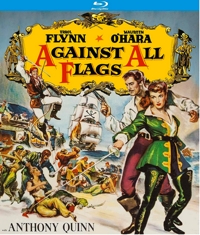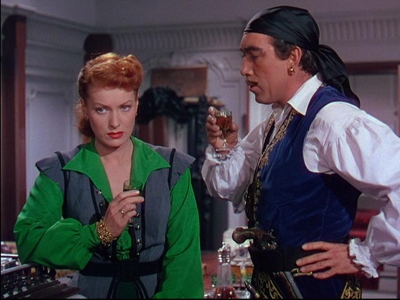 Grade: B-
Grade: B-
Adventure-Romance
Not rated (would be PG)
Hollywood made a lot of Westerns in the ‘30s, ‘40s, and ‘50s, but they also made a fair number of pirate movies. Against All Flags (1952) wasn’t one of the absolute best, but it gave audiences a rare pairing of Errol Flynn and Maureen O’Hara—both of whom had starred in swashbucklers before.
For Flynn, who first played a pirate in Captain Blood (1935) opposite Olivia de Havilland, his best swordplay was behind him. In Against All Flags he’s less jumpy, calmer, mellowed a bit with age, and no doubt slightly slowed by his bad-boy partying lifestyle. Yet, in this film that only makes him interestingly more human and less of a cardboard Hollywood leading man. For O’Hara, who had appeared in Spanish Main costumers with Tyrone Power and John Payne, The Black Swan remains her slightly superior pirate pic, but she’s at her feistiest in Against All Flags.
Here are my Top 10 pirate movies, so you can appreciate where I’m coming from:
- Pirates of the Caribbean: Curse of the Black Pearl (2003)—A
- Pirates of the Caribbean: Dead Man’s Chest (2006)—A
- Captain Blood (1935)—A
- The Sea Hawk (1940)—A-
- The Crimson Pirate (1952)—A-
- Pirates of the Caribbean: At World’s End (2007)—B+
- The Princess and the Pirate (1944)—B+
- Treasure Island (1950)—B
- The Black Swan (1942)—B
- Against All Flags (1952)—B-
 Growing up with Disney and Depp can spoil you, but those who are able to accept older films on their own terms will find Against All Flags pleasant escapist fare. Those used to seeing CGI or trick props will quickly realize that these are actual metal foils and swords, and they don’t have safety tips on them. Yes, there’s one camera shot that doesn’t capture the angle just right so that you can actually see a “stabbing” go several inches to the side of an abdomen. But after smiling, it occurs to you that the rest of the real-time action is fast and believable enough to require some precise stage combat skills to avoid injury. The actors did most of their own stunts, and that’s all but confirmed by the fact that Flynn broke his ankle during filming. There was only one scene where he reportedly used a stunt double for a rather extraordinary stunt.
Growing up with Disney and Depp can spoil you, but those who are able to accept older films on their own terms will find Against All Flags pleasant escapist fare. Those used to seeing CGI or trick props will quickly realize that these are actual metal foils and swords, and they don’t have safety tips on them. Yes, there’s one camera shot that doesn’t capture the angle just right so that you can actually see a “stabbing” go several inches to the side of an abdomen. But after smiling, it occurs to you that the rest of the real-time action is fast and believable enough to require some precise stage combat skills to avoid injury. The actors did most of their own stunts, and that’s all but confirmed by the fact that Flynn broke his ankle during filming. There was only one scene where he reportedly used a stunt double for a rather extraordinary stunt.
Even O’Hara gets into the act, and she’s as good with a blade as anyone on set. In fact, O’Hara is one big reason to watch this film. She famously complained to the Mirror in 1945, “Because I don’t let the producer and director kiss me every morning or let them paw me they have spread word around town that I am not a woman—that I am a cold piece of marble statuary.” Her character, “Spitfire,” is just as defiant when it comes to men. “I kiss when I want to kiss,” she says.  Not only does she fend men off as deftly as she handles a foil. She’s a feminist who also remains feminine despite her toughness, and that’s going to be of interest to young people who might be surprised to learn that there were strong female characters back in the ‘50s. Her character is all the more impressive compared to another woman, a Far Eastern princess (played by a white actress) who’s so helpless and naïve that she seeks kisses from Flynn’s character, with the running-gag request, “Again!”
Not only does she fend men off as deftly as she handles a foil. She’s a feminist who also remains feminine despite her toughness, and that’s going to be of interest to young people who might be surprised to learn that there were strong female characters back in the ‘50s. Her character is all the more impressive compared to another woman, a Far Eastern princess (played by a white actress) who’s so helpless and naïve that she seeks kisses from Flynn’s character, with the running-gag request, “Again!”
Though it’s ostensibly set in the Caribbean, Against All Flags was shot almost entirely at Universal Studios and remains a pretty good example of the studio back-lot film and the inventive set designs that kept the illusions going for audiences. It has all the colorful costumes from the Technicolor era, and real-looking sets and props. It’s only apparent in several dock shots that it’s a Hollywood set, with a background that looks two-dimensional until you see people walking in the distance. And the only really glaring anachronism is a crow’s nest that appears to be made of chain link mesh, which wasn’t invented until 1844.
But this isn’t a documentary, it’s an adventure, and that adventure begins with officer Brian Hawke being flogged and publicly broken in rank aboard a ship in the Royal British Navy. We quickly learn that it was staged, and Hawke and two other miscreants are put in a longboat. Their mission? To land on an impregnable island used as a base for pirates and somehow discover and disable the cannons that have been destroying the ships of any nation that tries to catch the pirates. With a signal that the mission has been accomplished, the British warship will enter the harbor to take on the pirates.
Brasiliano and the rest of the pirate captains are wary of Hawke, but his smooth gentlemanly ways make him a favorite of “Spitfire” Stevens (O’Hara), daughter of the gun and sword smith who was responsible for designing the island’s fortifications. She inherited a ship and an honorary captain’s title, and her word largely saves the three men so  they can attempt their mission—one that’s substantial enough to drive this film.
they can attempt their mission—one that’s substantial enough to drive this film.
Young history buffs will take additional pleasure in recognizing the names of real pirates that appear, including Roc Brasiliano (played by Anthony Quinn), Captain Kidd (Robert Warwick), and Bartholomew Roberts (James Logan), but except for Brasiliano they’re as fleeting onscreen as seagulls . . . or whatever birds fly near Universal Studios.
As always, Kino Lorber did a fine job with this reissue, as their catalog of classic films continues to expand. The visual images are sharp and the sound, though 2.0, has a nice presence to it. Could Captain Blood or The Crimson Pirate be next?
Entire family: No (but darned close)
Run time: 84 min., Color
Studio/Distributor: Kino Lorber
Aspect ratio: 1.37:1
Featured audio: DTS 2.0
Bonus features: C
Trailer
Amazon link
Not rated (would be PG for some violence)
Language: 0/10—Squeaky clean, mateys!
Sex: 2/10—Some forced kisses, some mutual, but that’s it
Violence: 4/10—Lots of cannon fire, swordfighting, and people doubling over and obviously dying, but the tone of the film and the bright colors can make it seem like movie action; there’s also a slap across the face, but overall far less violence than in the Pirates of the Caribbean series
Adult situations: 2/10—Drinking, swaggering, and men staked out at low tide awaiting death-by-crabs
Takeaway: It would have been interesting to see Flynn and O’Hara paired up earlier in their careers; they don’t sizzle here, but they are darned interesting together


Leave a comment